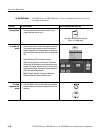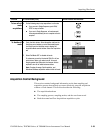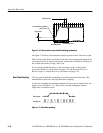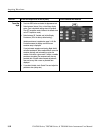
Acquiring Waveforms
CSA7000 Series, TDS7000 Series, & TDS6000 Series Instruments User Manual
3-45
1st Acquisition cycle
3rd Acquisition cycle
nth Acquisition cycle
2nd Acquisition cycle
Record points
Figure 3- 12: Equivalent-time sampling
The type of equivalent-time sampling the instrument uses is called random
equivalent-time sampling. Although it takes the samples sequentially in time, it
takes them randomly with respect to the trigger. Random sampling occurs
because the instrument sample clock runs asynchronously with respect to the
input signal and the signal trigger. The instrument takes samples independently
of the trigger position and displays them based on the time difference between
the sample and the trigger.
Your instrument can interpolate between the samples it acquires. Like for
equivalent time sampling, it does so only when it does not have all the real
samples it needs to fill its displayed waveform. When setting ZOOM to
progressively larger amounts of expansion, the instrument then interpolates to
create the intervening points in the displayed waveform. If the time per division
is set fast enough to require equivalent time but equivalent time is disabled, the
instrument interpolates points. There are two options for interpolation: linear or
sin(x)/x. (The instrument can also equivalent-time sample to acquire more
samples; see Equivalent-Time Sampling on page 3--43.)
Linear interpolation. Linear interpolation computes record points between actual
acquired samples by using a straight line fit. It assumes all the interpolated
points fall in their appropriate point in time on that straight line. Linear
interpolation is useful for many waveforms such as pulse trains.
Interpolation


















